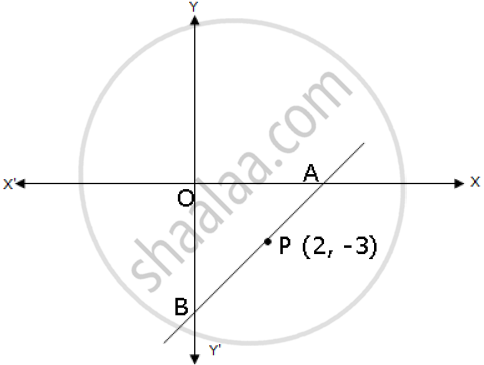Advertisements
Advertisements
प्रश्न
Determine whether the following point is collinear.
P(2, –5), Q(1, –3), R(–2, 3)
उत्तर
P(2, –5), Q(1, –3), R(–2, 3)
\[\text { Slope of PQ } = \frac{- 3 - \left( - 5 \right)}{1 - 2} = \frac{2}{- 1} = - 2\]
\[\text{ Slope of QR } = \frac{3 - \left( - 3 \right)}{- 2 - 1} = \frac{6}{- 3} = - 2\]
Slope of PQ = Slope of QR
So, the given points are collinear.
APPEARS IN
संबंधित प्रश्न
A and B are two points on the x-axis and y-axis respectively. P (2, −3) is the midpoint of AB. Find the:
(1) coordinates of A and B
(2) slope of line AB.
(3) an equation of line AB.

(−2, 4), (4, 8), (10, 7) and (11, –5) are the vertices of a quadrilateral. Show that the quadrilateral, obtained on joining the mid-points of its sides, is a parallelogram.
Find x, if the slope of the line joining (x, 2) and (8, −11) is `−3/4`.
A(5, 4), B(−3, −2) and C(1, −8) are the vertices of a triangle ABC. Find:
- the slope of the altitude of AB,
- the slope of the median AD and
- the slope of the line parallel to AC.
Find the value(s) of k so that PQ will be parallel to RS. Given : P(3, −1), Q(7, 11), R(−1, −1) and S(1, k)
The lines represented by 4x + 3y = 9 and px – 6y + 3 = 0 are parallel. Find the value of p.
Find the slope of the lines passing through the given point.
A(2, 3), B(4, 7)
Determine whether the following point is collinear.
A(–1, –1), B(0, 1), C(1, 3)
Determine whether the following point is collinear.
L(2, 5), M(3, 3), N(5, 1)
Find k, if B(k, –5), C (1, 2) and slope of the line is 7.
Show that A(4, –1), B(6, 0), C(7, –2) and D(5, –3) are vertices of a square.
Find the slope of a line, correct of two decimals, whose inclination is 60°
Find the slope of a line passing through the given pair of points (9,-2) and (-5,5)
Find the slope and the y-intercept of the following line 5x - 2y = 6
Find the slope and the y-intercept of the following line x - 2 = `(5 - 3"y")/2`
Write the equation of a line passing through the point P (0,6) and having slope 6/7.
Find the image of a point (-1, 2) in the line joining (2, 1) and (- 3, 2).
